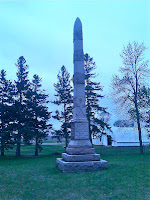 |
| Wood Lake Battlefield |
I journeyed this weekend to the great state of Minnesota to
present a talk on the First Minnesota Volunteers at the Battle of
Antietam. The presentation was
part of a day long program put together by the Twin City Civil War Symposium, a
group of round tables in Minnesota.
All of the programs were excellent and I made some new friends while
there. It surprised me that at
least 80% of the 200 or so attendees had been to the battlefield. I covered the route of the regiment
from the East Woods across the Cornfield and into the West Woods where their
brigade and the remainder of Sedgwick’s division was strongly attacked on the
left flank by elements of McLaw’s division and other Confederate troops. I had been perfecting this talk for
several months by making a number of treks into the West Woods with my fellow
guides and volunteers at Antietam.
Hopefully I will be able to offer this hike to the public while I
volunteer on weekends.
 |
| Wood Lake Monument Grounds |
I am sure that folks learned things about the battle of
Antietam from my talk. But like
many things in life, it is what I learned from my Minnesotan friends that are
worth mentioning. Recall that John
Pope was sent to Minnesota at the end of the Second Manassas Campaign. While the First Minnesota Volunteers were
engaged in the eastern campaigns during the summer of 1862, family and friends
back home faced a serious uprising by the Dakota people. Starting on August 17th, the
Dakotan Sioux frustrated by unfair treaties and bad faith began a killing spree
lead by Black Crow that engulfed the frontier. Isolated settlements were attacked and hundreds of civilians
were killed. The Sioux attacked
Fort Ridgely on the Minnesota River twice but were driven back. The large settlement of New Ulm held
off Indian attacks as well but the town was evacuated. Hundreds of refugee settlers headed
east. Lincoln faced a major crisis
on the western frontier at the same time that the Confederates were resurgent
in Maryland, Kentucky, and in Northern Mississippi. John Pope, recently defeated at Second Manassas, was sent to
Saint Paul to organize the defenses of the state. While many people nowadays may view this as exile, the
people of Minnesota did not see the crisis in that light and the reality is
that Pope’s assignment was an important and delicate one. He was welcomed with relief and anticipation
and to his credit, acted very effectively once he arrived. As the Maryland Campaign was
culminating at the Battle of Antietam on September 17th, the
Minnesota Campaign was also reaching a climax. On September 23, six days after the Battle of Antietam and
one day after Lincoln’s issuance of the preliminary Emancipation Proclamation,
Minnesota forces under Colonel Henry Sibley engaged the Sioux at Wood Lake
and decisively defeated them there.
While I have heard about the Dakota War in the context of
the Civil War, I knew few of the details.
That was about to change this weekend. During the symposium, I was introduced to Tom and Janet
Hosier who are the organizers of the Wood Lake Battlefield Preservation
Association. They graciously
offered to take me on a tour of the Wood Lake sight. Though the hour was late, we struck out for southwestern
Minnesota. For the next four
hours, Tom and Jan shared their knowledge on the Dakota War with Carol Van
Ornum, my friend with the Twin Cities Round Table and me. Carol had been
instrumental in securing my invitation to speak. She and her father had been on a private tour with me
several years ago.
 |
| Monument at Wood Lake |
I have never been to a frontier battlefield. Wood Lake has a
flag and monument on a one acre plot near the Rock Valle Lutheran Church, about
eleven miles east of Granite Falls.
Tom has secured an easement for an additional 50 acres of land and is
working on other easements. Plans
include some replanting of the tall luxuriant prairie grass that was present on
the ground at the day of the fight.
On our arrival shortly after 6PM, it was overcast and breezy. The sky darkened toward approaching
dusk. In the distance, I saw the
white two-spired Rock Valle Lutheran church (which was not there at the time). There is an air of infinite sadness at
this place. The wind blows through the grass and an
occasional bird chirps forlornly.
I had the same feeling as I often do when I stand at the fence line of
the Cornfield or the Sunken Road, or the Cemetery at Antietam. Despite the greater scope of battle and
forces involved, the Battle at Wood Lake was no less decisive for the Minnesota
frontier as the Battle of Antietam that had occurred six days earlier and half
a continent away, was.
I plan to learn more.
I purchased a book published by the Minnesota Historical Society Press
titled The Dakota War of 1862 - Minnesota’s Other Civil War, 1976, by
Kenneth Carley. I also
made a lifetime membership donation of $10 to the Wood Lake Battlefield
Preservation Association. If you
are interested in more details, check their website at www.woodlakebattlefield.com.

No comments:
Post a Comment